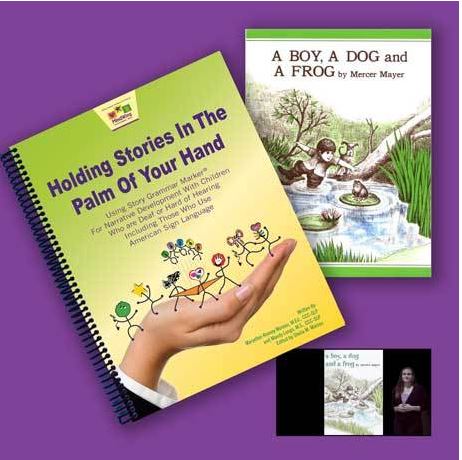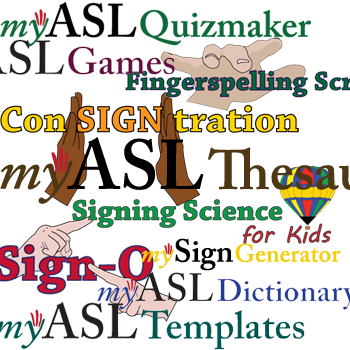Related Products
For Professionals
- Amplification
- Assessment of Student Skills, Challenges, Needs
- Early Childhood: Infants, Toddlers, Preschool
- Hearing Loss – Identification, Impact and Next Steps
- IDEA Law Summary Information
- Language and Speech Development Issues
- Legal Issues in Serving Children with Hearing Loss
- Listening (Auditory Skills) Development
- Planning to Meet Student Needs
- Self-Advocacy Skills for Students with Hearing Loss
- Self-Concept: How the Child with Hearing Loss Sees Himself
- Social Skills
- Speech Perception & Learning
Related Teacher Tools Takeout Items
Assessing Language Skills of ASL Communicators
Assessing the language level of young children can be challenging enough, then add that they use a different language, and on top of that, many are language deprived. We expect our students who use American Sign Language interpreters in the classroom to be able to fully access what is said, but how do we know that this is true? The first step is identifying their development of ASL as a full and complete language. Have they achieved age-appropriate language levels using ASL? This article shares some options to assess a student’s development of language skills in ASL.
Schools are required to ensure that communication for students who are deaf and hard of hearing are as effective as communication for others. To determine the level of communication effectiveness, appropriate assessment must occur. The teacher of the deaf/hard of hearing is typically the most qualified to be at the forefront of this assessment process. Some options for language assessment of learners who are ASL communicators are described below, presented in no particular order. Since language is developmental, checklists typically encompass the basic levels to higher levels of expertise. In this way, you can identify lacking skills to target for intervention, even if your student is beyond early childhood.
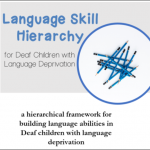 The Language Skill Hierarchy is intended to help clinicians and educators choose appropriate language skills to target with Deaf students with language deprivation. Created by www.language1st.org, the Hierarchy has no ages or grade levels, as it is meant to match the student’s current language abilities. It is also meant to be language-agnostic so that it can be used in oral or signed language as a guide for goal writing and activity planning. Per the Hierarchy developers, skills should be targeted in American Sign Language (ASL) first. If a Deaf child already has language deprivation, they need intensive language treatment in a fully accessible language (i.e., ASL). Clinicians should not begin to introduce printed English (aside from letters) until the child is at Level 2.
The Language Skill Hierarchy is intended to help clinicians and educators choose appropriate language skills to target with Deaf students with language deprivation. Created by www.language1st.org, the Hierarchy has no ages or grade levels, as it is meant to match the student’s current language abilities. It is also meant to be language-agnostic so that it can be used in oral or signed language as a guide for goal writing and activity planning. Per the Hierarchy developers, skills should be targeted in American Sign Language (ASL) first. If a Deaf child already has language deprivation, they need intensive language treatment in a fully accessible language (i.e., ASL). Clinicians should not begin to introduce printed English (aside from letters) until the child is at Level 2.
The Student Language and Communication Profile (Laurent Clerc National Deaf Education Center, Gallaudet University, 2010) is a structured means to gather data on a student’s proficiency level in the use of American Sign Language, also with application to students who (also) use spoken English. It includes extensive, criterion-referenced, skills in specific age ranges that assists knowledgeable school staff in identifying areas of strength and non-strength in comparison to age expectations. The Profile thus defines specific skills that will impact effective access of communication. This assessment is used to determine a student’s Kendall Conversational Proficiency Level (P-Level) for ASL and/or spoken English. There are 7 defined P-Levels in this assessment, commonly referred to as ‘the Kendall’.
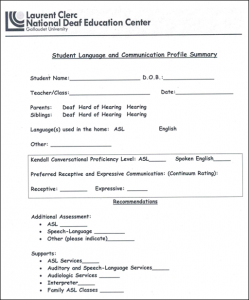 The Kendall Language and Communication Profile includes:
The Kendall Language and Communication Profile includes:
- ASL Skills Checklist for ages 0-24 months to be used in early intervention
- ASL Skills Checklist for 24-48 months
- ASL Development Checklist for Pre-Kindergarten (ages 4-5)
- ASL Skills Checklist for Kindergarten (ages 5-6)
- Early Childhood Education Preverbal Communication Intentions & Spoken English Development Checklist
- Receptive and Expressive Communication Continuums
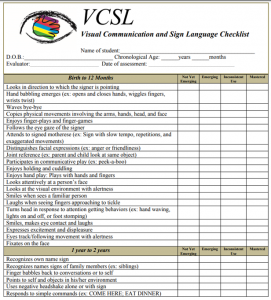 The Standardized Visual Communication Sign Language Checklist (Simms, Baker, and Clark, 2013) was developed to meet the need for a comprehensive checklist of visual language development so that learning goals can be set, gaps in learning identified, and appropriate materials developed. It documents the developmental milestones of children from birth to age 5 who are visual learners and are acquiring sign language regardless of their level of hearing. The VCSL stands out as a standardized checklist for assessing a child’s skills in American Sign Language. The VCSL should be completed in collaboration with people who are familiar with the child’s expressive and receptive language. Deaf and hard of hearing professionals could assist family members or professionals with less fluent signing skills, using a team approach.
The Standardized Visual Communication Sign Language Checklist (Simms, Baker, and Clark, 2013) was developed to meet the need for a comprehensive checklist of visual language development so that learning goals can be set, gaps in learning identified, and appropriate materials developed. It documents the developmental milestones of children from birth to age 5 who are visual learners and are acquiring sign language regardless of their level of hearing. The VCSL stands out as a standardized checklist for assessing a child’s skills in American Sign Language. The VCSL should be completed in collaboration with people who are familiar with the child’s expressive and receptive language. Deaf and hard of hearing professionals could assist family members or professionals with less fluent signing skills, using a team approach.
The American Sign Language Receptive Skills Test can assess the ability to perceive basic receptive ASL understanding of children ages 3-13 years. It measures emerging receptive knowledge of ASL, especially for children in the younger age ranges, including understanding of ASL grammar, number/distribution, negation, noun/verb distinction, spatial verbs, specifiers, handling classifiers, role shift, and conditionals. It is an ASL adaptation of the British Receptive Skills Test that consists of a vocabulary checklist of 20 words, 3 practice items, and a total of 42 test items. Includes a USB with all video stimuli and takes 10-15 minutes to administer. See the brief video showing the presentation of some test items from the ASL-RST. Research article.
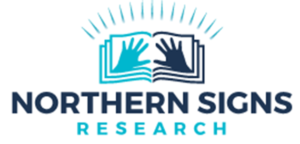 The American Sign Language Expressive Skills Test can assess expressive signed language, specifically their ability to produce a signed narrative (story) using appropriate ASL framer. For of children ages 4-13 years. You can use this test only after completing the training workshop to become ASL EST certified. The training in conducted in ASL, so all participants must be fluent ASL users.
The American Sign Language Expressive Skills Test can assess expressive signed language, specifically their ability to produce a signed narrative (story) using appropriate ASL framer. For of children ages 4-13 years. You can use this test only after completing the training workshop to become ASL EST certified. The training in conducted in ASL, so all participants must be fluent ASL users.
Also consider: When considering the level of effective communication access in the classroom, defining the student’s ASL skill level is necessary. Another critical aspect is the skill level of the classroom interpreter as comprehension relies completely on input of information. A 2005 study evaluated 2100 educational interpreters in the US using the Educational Interpreters Performance Assessment. The results found that about 60% of the interpreters evaluated had inadequate skills to provide full access. The study suggested that many students receive interpreter services that seriously hinder reasonable access to class curriculum and social interaction. Sufficient “through the air” access to verbal instruction and classroom communication cannot be assumed because accommodation by an interpreter is provided in the classroom.
Instructional Materials in ASL
Finding ‘just right’ instructional materials in ASL can be challenging. Below are some suggested resources.
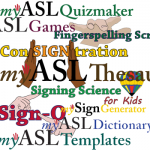 myASLTech.com is a website that enables you to create customized instructional materials with professional ASL graphics and videos in just minutes. It has a dictionary with tens of thousands of printable ASL graphics and videos, including definitions so you can create wonderful instructional materials. With the software on this website, you can build fingerspelling scrambles, matching games, crossword puzzles, and much more in a matter of seconds, automatically generate text with ASL supports, build quizzes with ASL graphics and videos, find signs according to handshapes and movements, play games, and read stories with ASL video translations. Info video.
myASLTech.com is a website that enables you to create customized instructional materials with professional ASL graphics and videos in just minutes. It has a dictionary with tens of thousands of printable ASL graphics and videos, including definitions so you can create wonderful instructional materials. With the software on this website, you can build fingerspelling scrambles, matching games, crossword puzzles, and much more in a matter of seconds, automatically generate text with ASL supports, build quizzes with ASL graphics and videos, find signs according to handshapes and movements, play games, and read stories with ASL video translations. Info video.
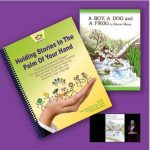 Holding Stories in the Palm of Your Hand focuses on narrative instruction and intervention with Story Grammar Marker® for children who are Deaf or Hard of Hearing. The goal is for all children to have the skills to independently and effectively communicate with anyone in their environment using their preferred modality of communication, including American Sign Language. This book also provides criterion-based assessments for narrative macro- and micro-structure for both English and American Sign Language.
Holding Stories in the Palm of Your Hand focuses on narrative instruction and intervention with Story Grammar Marker® for children who are Deaf or Hard of Hearing. The goal is for all children to have the skills to independently and effectively communicate with anyone in their environment using their preferred modality of communication, including American Sign Language. This book also provides criterion-based assessments for narrative macro- and micro-structure for both English and American Sign Language.
Apps from Sign2Read.com. See website for more information about the apps. All apps include a bilingual ASL-English picture dictionary of over 700 words and images.
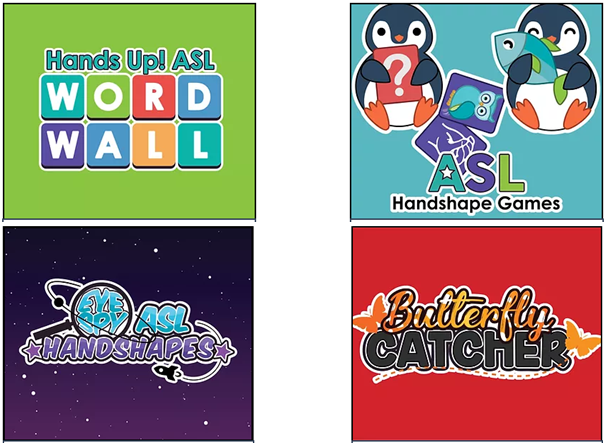
Author: Author: Karen L. Anderson, PhD
Click here to download this article

